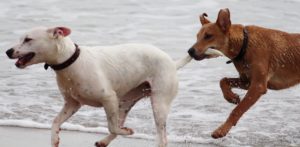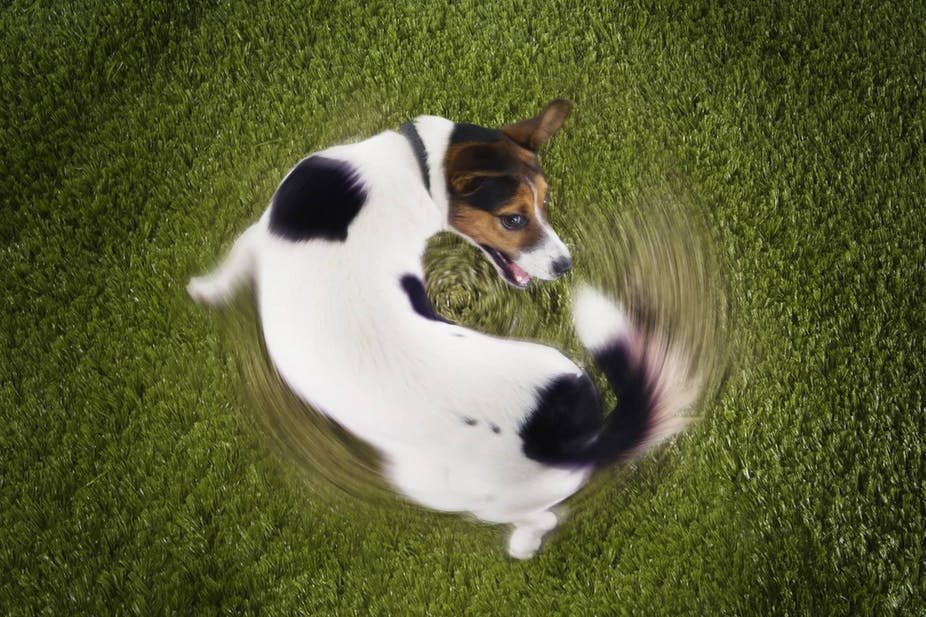Have you noticed that your dog is chewing his tail and can’t figure out why or how to help? You’re not alone! Being a pet owner can be challenging, especially because you cannot ask your dog to explain what they are feeling so that you can help. Instead, you have to be observant and act on what you see in order to help your dog. While it may just seem like an unusual behavior at first, persistent tail biting or chewing usually has a root cause that needs to be addressed in order for the chewing to stop. Below is an introductory guide that will cover common reasons for dog chewing on tail and what steps you should take to make sure your dog gets the help he needs.
Dog Chewing Tail Raw? Common Reasons for Tail Biting
When your dog is displaying compulsive and obsessive behavior, such as biting or chewing on his tail, it is generally an indication that there is someone else happening that is spurring their desire. There are a number of different reasons why your dog may be biting or chewing on their tail and finding the correct treatment plan is dependent on determining what the underlying issue may be. Below are a handful of common reasons for tail biting and chewing in dogs.
Allergies
Did you know that dogs can have allergies just like human beings? Dogs can have allergic reactions to fleas or ticks on their skin, which can result in a condition called canine dermatitis. Dermatitis is when the skin becomes inflamed due to environmental allergies. Dogs can be allergic to any number of elements in their environment, such as pollen floating in the air outside, the grass, chemicals used inside the house, the food they are consuming, and more. Dogs also can have allergic reactions due to contact with other animals or mites and their allergic reaction can be more severe when they are younger. Puppies between three and six months old will often have more intense reactions than older dogs.
Just as a human being would, when a dog is experiencing an allergic reaction, their instinct is to itch and scratch at the skin that is irritated. This is why some dogs experiencing allergies may be chewing or biting at their tail frequently to attempt to dispel the itchiness they are experiencing. Some pet owners may attempt to alleviate their dog’s itchy skin by giving them a bath and shampooing their fur, but in some cases, this can trigger another allergic reaction depending on what the dog is allergic to and what ingredients are in the soaps and/or shampoos used. If you believe your dog may be suffering from allergies, visit a licensed veterinarian to get them a full examination. It’s important to discuss your concerns with the veterinarian so that they can identify the potential allergens and develop a treatment plan.
Parasitic Infections
Another reason why your dog may be biting or chewing at his tail is due to a canine parasitic infection. Two of the most common culprits are fleas and ticks, which many dog owners are familiar with and already take preventative measures. The presence of fleas and ticks is often seasonal and easily noticeable by the dog itching and scratching at their skin to get rid of the fleas and/or ticks.
Thankfully, there are a variety of different methods available for warding off these pesky parasites, such as prescription medications, frequent baths, and medicated collars. But did you know that dogs could be itching and scratching at their tail due to something else the fleas and ticks are leaving behind? Some dogs are allergic to the saliva that these parasites leave on their skin when they bite them, which can trigger an allergic reaction. This allergic reaction can cause some dogs to compulsively bite and chew at their tail in an attempt to find relief from the discomfort and itchiness caused by the allergy.
Fleas and ticks aren’t the only types of parasites that can trigger this tail biting and chewing in dogs. While fleas and ticks are external parasites, tapeworms and roundworms are internal parasites that can cause the anus of a dog to become irritated and make them experience physical discomfort. In an attempt to rid himself of this discomfort, dogs can begin to gnaw and chew at the base of their tails.
Tapeworms can be spread to dogs through flea bites or when a dog eats a flea that is carrying tapeworm eggs. Roundworms are more common in young dogs and puppies. If you think your dog may be suffering from a parasitic infection, visit a licensed veterinarian who will be able to perform a full examination and run any necessary tests to determine what type of parasitic infection your dog is suffering from and how he needs to be treated.
Stress and Anxiety
 Stress and anxiety aren’t unique human traits; dogs can also experience stress, anxiety, and boredom that can lead to destructive behaviors. For some dogs, their stress and anxiety may cause them to destroy items around them, like their owner’s favorite pair of shoes or a house plant, but for other dogs, it can result in compulsive behaviors like chewing or biting at his tail. This can be more likely for a dog that has been put in a crate or confined for an extended period of time since the only object they have to relieve their stress and anxiety upon is their own body. To reduce canine anxiety, it may be necessary to work with a trainer to address the issue or incorporate additional exercise and mental stimulation into their daily routine.
Stress and anxiety aren’t unique human traits; dogs can also experience stress, anxiety, and boredom that can lead to destructive behaviors. For some dogs, their stress and anxiety may cause them to destroy items around them, like their owner’s favorite pair of shoes or a house plant, but for other dogs, it can result in compulsive behaviors like chewing or biting at his tail. This can be more likely for a dog that has been put in a crate or confined for an extended period of time since the only object they have to relieve their stress and anxiety upon is their own body. To reduce canine anxiety, it may be necessary to work with a trainer to address the issue or incorporate additional exercise and mental stimulation into their daily routine.
Hot Spots
Has your dog ever had a hot spot before? When a dog repeatedly licks and chews at a certain spot on their body for an extended period of time, they can create an open wound on the surface of their skin from the repeated chewing, which is called a hot spot. Hot spots on dogs thrive in conditions that are moist and warm and are a breeding ground for secondary infections to develop. If your dog has a hot spot on his tail, the repeated chewing and biting of their skin will exacerbate the hot spot. Hot spots are recognizable by matted hair, blood, pus, and/or reddened and irritated skin.
If your dog is biting and chewing at his tail due to a hot spot, reach out to a licensed veterinarian to get a full examination and check that there is not a secondary infection present. A veterinarian will be able to advise on how best to treat the hot spot and prevent it from becoming larger. The sooner your dog gets treatment for his problem, the sooner he will stop biting and chewing at his tail.
Impacted Anal Glands
One reason why your dog may be biting or chewing his tail is that his anal glands are impacted. Many dog owners don’t realize the importance of their dog’s anal glands unless there is an issue, but these glands are a vital mechanism for social interactions between other canines. Dogs have anal glands on both sides of their anus that produce a distinctive smelling fluid that dogs use to mark their territory and alert other dogs of their presence. Socially, a dog’s anal glands function in a similar way to a handshake for human beings. When dogs smell each other’s behinds upon meeting, they are sniffing the scent of the anal gland fluid on one another.
Most dogs secrete a fluid from their anal glands when they defecate due to the pressure exerted onto the glands, but in some dogs, the anal glands can become clogged due to a variety of reasons, such as allergies or stool that is too soft to exert pressure on the anal glands. When this occurs, the anal glands become impacted and can result in the dog experiencing significant discomfort. This discomfort will usually result in the dog scooting their behind along the ground and biting or chewing at the base of their tail to attempt to alleviate their discomfort. Some dogs may also begin to secrete a foul smell from their rear end, have trouble defecting, or have blood in his stool.
If your dog is exhibiting these symptoms, it is vital to see a licensed veterinarian immediately so that they can perform a proper exam and relieve your dog of his problem. In some cases, the dog may develop an infection or abscess due to the impacted anal glands, which will require additional treatment.
Injured Tail/Hindquarter Area
When dogs are in pain, they are likely to display out-of-character behaviors in an attempt to alert their owner to the pain they are experiencing. When a dog has an injury to his legs, tail, or hindquarter region, this can result in him chewing or biting at his tail. The injury could be a dislocation, abrasion, laceration, or fracture and veterinary intervention will be necessary to determine what type of injury has occurred, its severity, and what the best course of treatment is to alleviate the dog’s pain as soon as possible and allow them to heal correctly. A veterinarian may require the use of X-rays of the affected area to accurately determine the cause of the pain.
Poor Hygiene
In some dogs, his compulsive behavior can be an indication of poor hygiene. When their anal area is itchy and irritated, they will attempt to rectify the issue by chewing and biting at the affected area. This can stem from stool becoming attached to the hair around the anus that can then become matted. When this occurs, it is called fecal mats and can cause the dog’s skin around the anus to become irritated and even infected in some cases. If the condition persists, flies can begin to gather around the affected area and maggots can infest a dog’s skin. This can be uncomfortable for the dog and will require thorough cleaning and prescription medications to combat the infestation.
Playful Behavior
 One unsuspecting cause of tail biting and chewing is playful behavior. Dogs can be fun and silly creatures that interact with their own bodies and the world around them. For some dogs, this can mean thinking of their tail as a toy that they will chase, bite, and chew. This type of playful behavior is more common in puppies and young dogs that are becoming aware of their growing bodies. Typically as dogs age and mature, they outgrow this type of playful behavior and begin to turn their desire for playtime with toys given to them by their owners or other objects instead.
One unsuspecting cause of tail biting and chewing is playful behavior. Dogs can be fun and silly creatures that interact with their own bodies and the world around them. For some dogs, this can mean thinking of their tail as a toy that they will chase, bite, and chew. This type of playful behavior is more common in puppies and young dogs that are becoming aware of their growing bodies. Typically as dogs age and mature, they outgrow this type of playful behavior and begin to turn their desire for playtime with toys given to them by their owners or other objects instead.
Some owners may unknowingly encourage playfully chewing and biting at the tail by positively reinforcing the behavior. For example, if the dog is given attention whenever it begins to nibble on his tail, he may attempt to recreate this behavior to get that attention again. In this case, it may require training and repetition to help a dog learn not to chew or bite at his tail and to teach them to turn their sights on more appropriate objects to play with.
How to Help Your Dog
If your dog is persistently biting and chewing at his tail, it is important to seek out a licensed veterinarian that will be able to perform a full assessment of your dog’s symptoms and behaviors and any necessary tests to determine the root cause of the behavior. From these results, the veterinarian will be able to deduce what the most likely cause is and advise on the recommended treatment plan. The sooner the underlying reason for the tail chewing is discovered, the sooner your dog can get back to enjoying his life.
Sources:
Peña, Melvin. “Tail Biting in Dogs – What Are the Causes?” Dogster, 1 Nov. 2018, www.dogster.com/lifestyle/why-does-my-dog-keep-biting-her-tail-and-whining.
“Biting His Tail in Dogs – Definition, Cause, Solution, Prevention, Cost.” WagWalking, 25 May 2017, wagwalking.com/symptom/why-is-my-dog-biting-his-tail.
Farricelli, Adrienne. “Why Does a Dog Chew on His Tail?” Pets The Nest, 21 Nov. 2017, pets.thenest.com/dog-chew-his-tail-3939.html.




